Refine search
No keyword found to refine search
keywords EN
Places
Names
215 documents found
| 1 | 4 |
Documents per page :
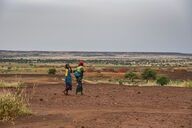
Flooding Tahoua region, Niger
Nicolas Réméné / Le Pictorium
LePictorium_0293834.jpg
Women walk along a small pond that has formed in a village affected by the heavy rains of recent days in the Tilia department and Tahoua region.
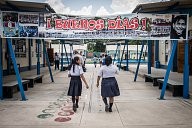
Water keepers
Olivier Donnars / Le Pictorium
LePictorium_0240733.jpg
In the village of Santa Rosa, in the heart of the Amazonian region of Madre de Dios, students from the Jose Carlos Mariategui middle school are taking part in a prevention campaign on the health risks linked to mercury. Since 2016, this campaign has been carried out in 4 other schools in the region by members of the Centro de Innovación Científica Amazónica (CINCIA) and rangers from the National Service of State Protected Natural Spaces (Sernanp).
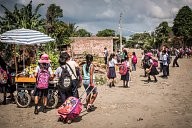
Water keepers
Olivier Donnars / Le Pictorium
LePictorium_0240734.jpg
In the village of Santa Rosa, in the heart of the Amazonian region of Madre de Dios, students from the Jose Carlos Mariategui middle school are taking part in a prevention campaign on the health risks linked to mercury. Since 2016, this campaign has been carried out in 4 other schools in the region by members of the Centro de Innovación Científica Amazónica (CINCIA) and rangers from the National Service of State Protected Natural Spaces (Sernanp).
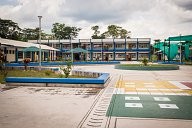
Water keepers
Olivier Donnars / Le Pictorium
LePictorium_0240735.jpg
In the village of Santa Rosa, in the heart of the Amazonian region of Madre de Dios, students from the Jose Carlos Mariategui middle school are taking part in a prevention campaign on the health risks linked to mercury. Since 2016, this campaign has been carried out in 4 other schools in the region by members of the Centro de Innovación Científica Amazónica (CINCIA) and rangers from the National Service of State Protected Natural Spaces (Sernanp).
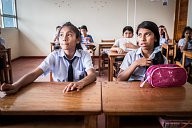
Water keepers
Olivier Donnars / Le Pictorium
LePictorium_0240736.jpg
In the village of Santa Rosa, in the heart of the Amazonian region of Madre de Dios, students from the Jose Carlos Mariategui middle school are taking part in a prevention campaign on the health risks linked to mercury. Since 2016, this campaign has been carried out in 4 other schools in the region by members of the Centro de Innovación Científica Amazónica (CINCIA) and rangers from the National Service of State Protected Natural Spaces (Sernanp).
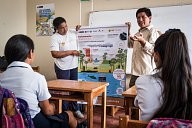
Water keepers
Olivier Donnars / Le Pictorium
LePictorium_0240737.jpg
Marta Torres (left) from the Centro de innovacion cientifica Amazonica (Cincia) and Jorge Lezama de la Sernanp (right) explain that mercury is a metal that is highly toxic both to the environment and to human health. Chronic intoxication with elemental mercury is manifested by various non-specific disorders: insomnia, nausea, depression, tremors, aggressiveness, memory problems. One speaks about silent intoxication.
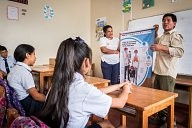
Water keepers
Olivier Donnars / Le Pictorium
LePictorium_0240738.jpg
Marta Torres (left) from the Centro de innovacion cientifica Amazonica (Cincia) and Jorge Lezama de la Sernanp (right) explain that mercury is a metal that is highly toxic both to the environment and to human health. Chronic intoxication with elemental mercury is manifested by various non-specific disorders: insomnia, nausea, depression, tremors, aggressiveness, memory problems. One speaks about silent intoxication.
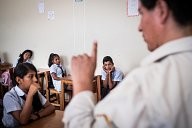
Water keepers
Olivier Donnars / Le Pictorium
LePictorium_0240739.jpg
Jorge Lezama de la Sernanp explains that mercury is a highly toxic metal both for the environment and for human health. A chronic intoxication with elemental mercury manifests itself by various non-specific disorders: insomnia, nausea, depression, tremors, aggressiveness, memory problems. One speaks about silent intoxication.
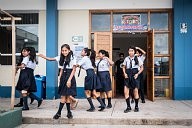
Water keepers
Olivier Donnars / Le Pictorium
LePictorium_0240740.jpg
The children leave for the Rio Tigre Mayo, a small river flowing near their school. Some of them are the children of illegal gold miners - and hide from them - but participate in the "Water Guardians" program, run by Cincia.
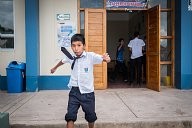
Water keepers
Olivier Donnars / Le Pictorium
LePictorium_0240741.jpg
The children leave for the Rio Tigre Mayo, a small river flowing near their school. Some of them are the children of illegal gold miners - and hide from them - but participate in the "Water Guardians" program, run by Cincia.
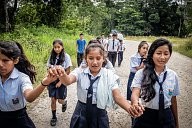
Water keepers
Olivier Donnars / Le Pictorium
LePictorium_0240742.jpg
The children leave for the Rio Tigre Mayo, a small river flowing near their school. Some of them are the children of illegal gold miners - and hide from them - but participate in the "Water Guardians" program, run by Cincia.
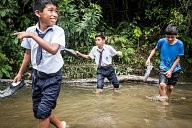
Water keepers
Olivier Donnars / Le Pictorium
LePictorium_0240743.jpg
The children leave for the Rio Tigre Mayo, a small river flowing near their school. Some of them are the children of illegal gold miners - and hide from them - but participate in the "Water Guardians" program, run by Cincia.
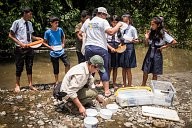
Water keepers
Olivier Donnars / Le Pictorium
LePictorium_0240744.jpg
Toxic mercury exists in two forms. The inorganic (liquid or vapour), is the one that miners inhale and release into rivers. Once in the aquatic sediments, it is transformed into methylmercury (or organic mercury) by bacteria. Then it is ingested by small fish living on the bottom, which in turn are consumed by larger fish. It is in these large fish, most often carnivorous, that mercury concentrations are 100 to 1000 times higher. Children learn to eat only herbivorous fish, such as pacu, which are less contaminated with mercury.
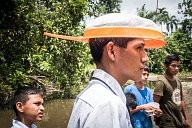
Water keepers
Olivier Donnars / Le Pictorium
LePictorium_0240745.jpg
Using nets, they harvest small aquatic invertebrates, including dragonfly larvae. The diversity and quantity of these invertebrates are indicators of good water quality.
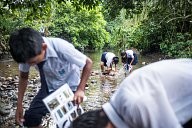
Water keepers
Olivier Donnars / Le Pictorium
LePictorium_0240746.jpg
Using nets, they harvest small aquatic invertebrates, including dragonfly larvae. The diversity and quantity of these invertebrates are indicators of good water quality.
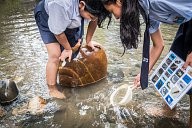
Water keepers
Olivier Donnars / Le Pictorium
LePictorium_0240747.jpg
Using nets, they harvest small aquatic invertebrates, including dragonfly larvae. The diversity and quantity of these invertebrates are indicators of good water quality.
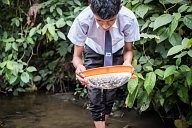
Water keepers
Olivier Donnars / Le Pictorium
LePictorium_0240748.jpg
Using nets, they harvest small aquatic invertebrates, including dragonfly larvae. The diversity and quantity of these invertebrates are indicators of good water quality.

Water keepers
Olivier Donnars / Le Pictorium
LePictorium_0240749.jpg
Using nets, they harvest small aquatic invertebrates, including dragonfly larvae. The diversity and quantity of these invertebrates are indicators of good water quality.
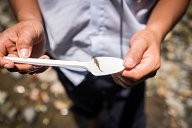
Water keepers
Olivier Donnars / Le Pictorium
LePictorium_0240750.jpg
Using nets, they harvest small aquatic invertebrates, including dragonfly larvae. The diversity and quantity of these invertebrates are indicators of good water quality.
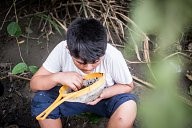
Water keepers
Olivier Donnars / Le Pictorium
LePictorium_0240751.jpg
Using nets, they harvest small aquatic invertebrates, including dragonfly larvae. The diversity and quantity of these invertebrates are indicators of good water quality.
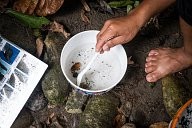
The guardians of the water
Olivier Donnars / Le Pictorium
LePictorium_0240752.jpg
All collected invertebrates are meticulously recorded. The diversity and quantity of invertebrates, particularly dragonfly larvae, are indicators of good water quality and mercury contamination. Scientists are also interested in them because they also enter the food chain of fish consumed by local populations.
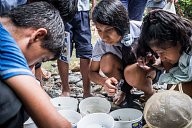
Water keepers
Olivier Donnars / Le Pictorium
LePictorium_0240753.jpg
All invertebrates harvested are meticulously catalogued. The diversity and quantity of invertebrates, including dragonfly larvae, are indicators of good water quality and mercury contamination. Scientists are also interested in them because they also enter the food chain of fish consumed by local populations.

Water keepers
Olivier Donnars / Le Pictorium
LePictorium_0240754.jpg
All invertebrates harvested are meticulously catalogued. The diversity and quantity of invertebrates, including dragonfly larvae, are indicators of good water quality and mercury contamination. Scientists are also interested in them because they also enter the food chain of fish consumed by local populations.
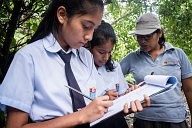
Water keepers
Olivier Donnars / Le Pictorium
LePictorium_0240755.jpg
All invertebrates harvested are meticulously catalogued. The diversity and quantity of invertebrates, including dragonfly larvae, are indicators of good water quality and mercury contamination. Scientists are also interested in them because they also enter the food chain of fish consumed by local populations.

Water keepers
Olivier Donnars / Le Pictorium
LePictorium_0240756.jpg
A schoolgirl shows a poster indicating all the types of invertebrates, including dragonfly larvae, that can be found in the stream and whose presence is a good indicator of good water quality.

Water keepers
Olivier Donnars / Le Pictorium
LePictorium_0240757.jpg
Marta Torrès, in charge of environmental awareness programs for the Centro de Innovación Científica Amazónica (CINCIA), shows a leaflet developed by CINCIA based on analyses carried out in the region's rivers, indicating which fish are edible and which are not.
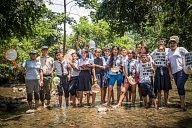
Water keepers
Olivier Donnars / Le Pictorium
LePictorium_0240758.jpg
The students of the Jose Carlos Mariategui College in the village of Santa Rosa, in the heart of the Amazonian region of Madre de Dios. They are taking part in a prevention campaign on the health risks linked to mercury in the Mayo Tiger River that flows near their school.
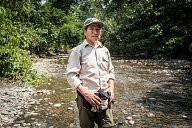
Water keepers
Olivier Donnars / Le Pictorium
LePictorium_0240759.jpg
Jorge Lezama is an environmental educator for the Tambopata National Reserve, one of the most important biodiversity reserves in Peru. He takes his role as an educator very seriously. He knows that some of the fathers of these children are illegal miners; some teenagers also work in the mines on weekends. But for him, there is no question of making distinctions or criticisms. "All activities are compatible with the environment if you understand how the environment works and how to preserve it.
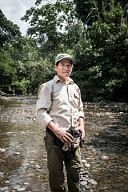
Water keepers
Olivier Donnars / Le Pictorium
LePictorium_0240760.jpg
Jorge Lezama is an environmental educator for the Tambopata National Reserve, one of the most important biodiversity reserves in Peru. He takes his role as an educator very seriously. He knows that some of the fathers of these children are illegal miners; some teenagers also work in the mines on weekends. But for him, there is no question of making distinctions or criticisms. "All activities are compatible with the environment if you understand how the environment works and how to preserve it.
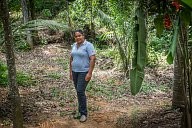
Water keepers
Olivier Donnars / Le Pictorium
LePictorium_0240761.jpg
Marta Torrès is in charge of environmental awareness programs for the Centro de Innovación Científica.
Amazónica (CINCIA). "We are not here to criticize mining activity but to talk about it like any other activity. Our role is to raise awareness of the problem of mercury, the usefulness of reforesting damaged plots and to show that there are alternative practices to the use of mercury in mining. ”
Amazónica (CINCIA). "We are not here to criticize mining activity but to talk about it like any other activity. Our role is to raise awareness of the problem of mercury, the usefulness of reforesting damaged plots and to show that there are alternative practices to the use of mercury in mining. ”
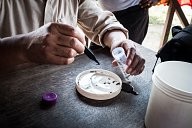
Water keepers
Olivier Donnars / Le Pictorium
LePictorium_0240762.jpg
Jorge Lezama isolates dragonfly larvae collected with the schoolboys in the Rio Tigre Mayo. The larvae are then preserved in alcohol before being analyzed in the laboratory to determine their mercury content. The results will then be given to the water keepers.
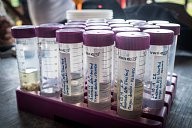
Water keepers
Olivier Donnars / Le Pictorium
LePictorium_0240763.jpg
Jorge Lezama isolates dragonfly larvae collected with the schoolboys in the Rio Tigre Mayo. The larvae are then preserved in alcohol before being analyzed in the laboratory to determine their mercury content. The results will then be given to the water keepers.
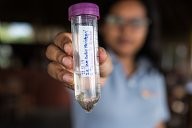
Water keepers
Olivier Donnars / Le Pictorium
LePictorium_0240764.jpg
Jorge Lezama isolates dragonfly larvae collected with the schoolboys in the Rio Tigre Mayo. The larvae are then preserved in alcohol before being analyzed in the laboratory to determine their mercury content. The results will then be given to the water keepers.
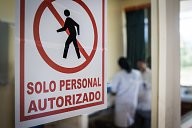
Water keepers
Olivier Donnars / Le Pictorium
LePictorium_0240765.jpg
In the laboratory of the Centro de innovacion cientifica Amazonica (Cincia) on the outskirts of Puerto Maldonado, the main city of the Madre de Dios region. The laboratory is isolated from the city, instead of the forest to avoid any source of mercury contamination.
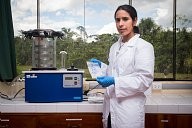
Water keepers
Olivier Donnars / Le Pictorium
LePictorium_0240766.jpg
Claudia Vega, head of the mercury department of the Centro de innovacion cientifica Amazonica (Cincia) in Puerto Maldonado. In her laboratory, she analyzes the level of methylmercury absorbed by fish in the Madre de Dios region as well as the larvae of dragonflies of the "water guardians". Her analyses have made it possible to determine which types of fish could or could not be eaten. And which rivers are the least contaminated.
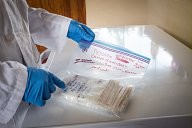
Water keepers
Olivier Donnars / Le Pictorium
LePictorium_0240767.jpg
In the laboratory of the Centro de innovacion cientifica Amazonica (Cincia) next to Puerto Maldonado. Claudia Vega, its manager, shows a sample of frozen fish, used to measure the level of methylmercury absorbed by fish in the Madre de Dios region.
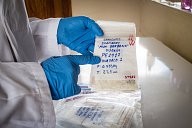
Water keepers
Olivier Donnars / Le Pictorium
LePictorium_0240768.jpg
In the laboratory of the Centro de innovacion cientifica Amazonica (Cincia) next to Puerto Maldonado. Claudia Vega, its manager, shows a sample of frozen fish, used to measure the level of methylmercury absorbed by fish in the Madre de Dios region.
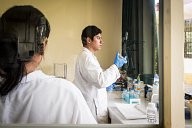
Water keepers
Olivier Donnars / Le Pictorium
LePictorium_0240769.jpg
In the laboratory of the Centro de innovacion cientifica Amazonica (Cincia) in Puerto Maldonado, a researcher is analyzing the level of methylmercury absorbed by fish in the Madre de Dios region.
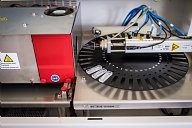
Water keepers
Olivier Donnars / Le Pictorium
LePictorium_0240770.jpg
In the laboratory of the Centro de innovacion cientifica Amazonica (Cincia) next to Puerto Maldonado. Detail of the analyzer used to measure the level of methylmercury absorbed by fish in the Madre de Dios region.
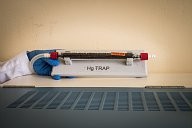
Water keepers
Olivier Donnars / Le Pictorium
LePictorium_0240771.jpg
In the laboratory of the Centro de innovacion cientifica Amazonica (Cincia) next to Puerto Maldonado. Detail of the analyzer used to measure the level of methylmercury absorbed by fish in the Madre de Dios region.
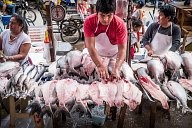
Water keepers
Olivier Donnars / Le Pictorium
LePictorium_0240772.jpg
In the market of Puerto Maldonado, the main town of the Madre de Dios region, a seller of Pacu, a fish related to piranhas but herbivorous. It is one of the fish least contaminated with mercury and is therefore edible. In the big city, the inhabitants are now informed about the risks but only on the indications given by CINCIA.
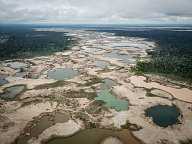
Dirty gold from Peru
Olivier Donnars / Le Pictorium
LePictorium_0234869.jpg
In the Amazonian region of Madre de Dios in Peru, La pampa, a vast area devastated by illegal gold mining. The band follows the vein of the precious ore through the forest. Nearly 960 km2 of forest have been devastated in 30 years by the illegal exploitation of gold and contaminated with mercury. The area borders the Tambopata National Reserve where the miners broke in, destroying 7.95 km2 of forest, one of the richest in biodiversity.
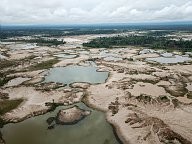
Dirty gold from Peru
Olivier Donnars / Le Pictorium
LePictorium_0234870.jpg
In the Amazonian region of Madre de Dios in Peru, La pampa, a vast area devastated by illegal gold mining. The band follows the vein of the precious ore through the forest. Nearly 960 km2 of forest have been devastated in 30 years by the illegal exploitation of gold and contaminated with mercury. The area borders the Tambopata National Reserve where the miners broke in, destroying 7.95 km2 of forest, one of the richest in biodiversity.
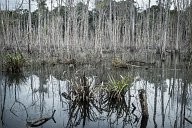
Dirty gold from Peru
Olivier Donnars / Le Pictorium
LePictorium_0234871.jpg
In La Pampa, a forest of completely dead trees, contaminated with mercury. Illegal miners have left 30 km2 of excavations, sometimes 7 m deep, where all the organic matter in the soil has been leached and contaminated with mercury. During the rainy season, the polluted water seeps into the soil and into the many rivers, contaminating the fish consumed by the local population, especially the indigenous people who live along the rivers.

Dirty gold from Peru
Olivier Donnars / Le Pictorium
LePictorium_0234872.jpg
In La Pampa, a forest of completely dead trees, contaminated with mercury. Illegal miners have left 30 km2 of excavations, sometimes 7 m deep, where all the organic matter in the soil has been leached and contaminated with mercury. During the rainy season, the polluted water seeps into the soil and into the many rivers, contaminating the fish consumed by the local population, especially the indigenous people who live along the rivers.
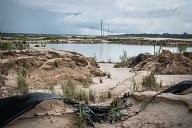
Dirty gold from Peru
Olivier Donnars / Le Pictorium
LePictorium_0234873.jpg
In La Pampa, in the region of Madre de Dios (Peru), illegal miners dug excavations sometimes 7 m deep, washing all the soil of its organic matter. Mercury-polluted "lakes" where nothing lives. On 100 km2 of old forest, there are now 30 km2 of new polluted lakes. During the rainy season, some of these lakes overflow. The polluted water seeps into the soil, even into the many rivers running through the region, contaminating the fish, which are very much consumed by the local populations, especially the natives living along the rivers.

Dirty gold from Peru
Olivier Donnars / Le Pictorium
LePictorium_0234874.jpg
In La Pampa, in the region of Madre de Dios (Peru), illegal miners dug excavations sometimes 7 m deep, washing all the soil of its organic matter. Mercury-polluted "lakes" where nothing lives. On 100 km2 of old forest, there are now 30 km2 of new polluted lakes. During the rainy season, some of these lakes overflow. The polluted water seeps into the soil, even into the many rivers running through the region, contaminating the fish, which are very much consumed by the local populations, especially the natives living along the rivers.
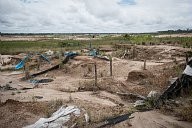
Dirty gold from Peru
Olivier Donnars / Le Pictorium
LePictorium_0234875.jpg
On the site of La Pampa, the remains of makeshift plastic campsites. Until the beginning of 2019, 25,000 people lived on the La Pampa site, minors with women and children, in extreme conditions, without any health services. Many survived in wooden and blue plastic shacks, and moved around as the mining went on. A poor unemployed population, coming from the neighboring Andes, and completely forgotten by the central government, attracted by the prospect of finally getting out of misery with quick profits: income of 5000 soles per month (1330 €) when the minimum wage in Peru is 230 €. A whole clandestine economy - shops, hotels, bars, restaurants, brothels - generated by the mines had been set up with its cortege of nuisances: human trafficking, sexual exploitation of young minors, elementary human rights violated, alcoholism, arms trafficking, organized crime.
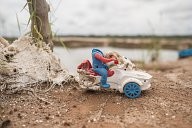
Dirty gold from Peru
Olivier Donnars / Le Pictorium
LePictorium_0234876.jpg
On the site of La Pampa, an abandoned toy. Until the beginning of 2019, 25,000 people lived on the La Pampa site, minors with women and children, in extreme conditions, without any health services. Many survived in wooden and blue plastic shacks, and moved around as the mining went on. A poor unemployed population, coming from the neighboring Andes, and completely forgotten by the central government, attracted by the prospect of finally getting out of misery with quick profits: income of 5000 soles per month (1330 €) when the minimum wage in Peru is 230 €. A whole clandestine economy - shops, hotels, bars, restaurants, brothels - generated by the mines was set up with its procession of nuisances: human trafficking, sexual exploitation of underage girls, elementary human rights violated, alcoholism, arms trafficking, organized crime.
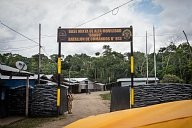
Dirty gold from Peru
Olivier Donnars / Le Pictorium
LePictorium_0234877.jpg
The entrance to one of the military bases on the outskirts of La Pampa. In February 2019, the Peruvian government dispatched 300 military, 1200 police, and 70 prosecutors for 14 days to hunt down illegal minors and regain control of the area. This operation, known as Operation Mercurio 2019, followed several smaller police and military interventions in previous years, which were unsuccessful. After recapturing the area, the government established three permanent bases at the gates of La Pampa, which are expected to remain there until 2021. Three hundred military personnel are responsible for preventing the return of the miners and dislodging those still there.
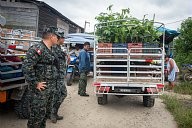
Dirty gold from Peru
Olivier Donnars / Le Pictorium
LePictorium_0234878.jpg
At the end of November 2019, a dozen soldiers of the Peruvian Navy Special Forces escorted a convoy of shrubs. The shipment of plants leaves for the devastated part of the Tambopata National Reserve, under the watchful eye of the marines and rangers of the National Service of State Protected Natural Spaces (Sernanp).
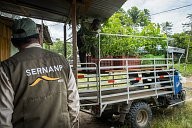
Dirty gold from Peru
Olivier Donnars / Le Pictorium
LePictorium_0234879.jpg
At the end of November 2019, a dozen soldiers of the Peruvian Navy Special Forces escorted a convoy of shrubs. The shipment of plants leaves for the devastated part of the Tambopata National Reserve, under the watchful eye of the marines and rangers of the National Service of State Protected Natural Spaces (Sernanp).
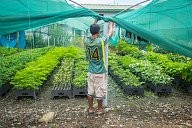
Dirty gold from Peru
Olivier Donnars / Le Pictorium
LePictorium_0234880.jpg
In Mazuco, 120 km from Puerto Maldonado, capital of the Madre de Dios region, there is a nursery installed by the Centro de innovacion cientifica Amazonica (Cincia) where 14 species of trees grow. To restore the magnificent tropical forest of the Tambopata reserve, the Peruvian authorities made the crazy bet to reforest everything. These species were selected for their ability to grow in impoverished and degraded soil. The 140,000 seedlings will go to reforest the deforested lands of the Tambopata National Reserve. Experimental work began in 2016, with the financial support of the WWF (World Wildife Fund) and then the American agency USAID.
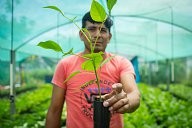
Dirty gold from Peru
Olivier Donnars / Le Pictorium
LePictorium_0234881.jpg
In Mazuco, 120 km from Puerto Maldonado, a technician presents an amasisa plant (erythrina ulei), one of the 14 species of trees grown in the nursery of the Centro de innovacion cientifica Amazonica (Cincia). These species were selected for their ability to grow in impoverished and degraded soil. The 140,000 seedlings will be used to reforest the deforested lands of the Tambopata National Reserve.
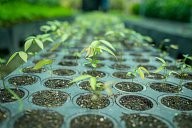
Dirty gold from Peru
Olivier Donnars / Le Pictorium
LePictorium_0234882.jpg
Young shoots of Chinbillo (Inga), one of the 14 species of trees grown in the nursery of the Centro de innovacion cientifica Amazonica (Cincia) in Mazuco. These species were selected for their ability to grow in impoverished and degraded soil. The 140,000 seedlings will be used to reforest the deforested lands of the Tambopata National Reserve.
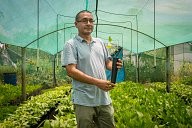
Dirty gold from Peru
Olivier Donnars / Le Pictorium
LePictorium_0234883.jpg
France Cabanillas, agricultural engineer and head of the reforestation department of the Centro de innovacion cientifica Amazonica (Cincia) in the middle of the nursery he set up to reforest the devastated area of the Pampa.
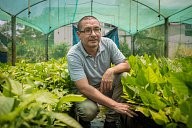
Dirty gold from Peru
Olivier Donnars / Le Pictorium
LePictorium_0234884.jpg
France Cabanillas, agricultural engineer and head of the reforestation department of the Centro de innovacion cientifica Amazonica (Cincia) in the middle of the nursery he set up to reforest the devastated area of the Pampa.
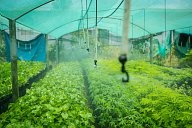
Dirty gold from Peru
Olivier Donnars / Le Pictorium
LePictorium_0234885.jpg
In Mazuco, 120 km from Puerto Maldonado, a nursery where 14 species of trees grow, installed by the Centro de innovacion cientifica Amazonica (Cincia). These species were selected for their ability to grow in impoverished and degraded soil. The 140,000 seedlings will be used to reforest the deforested lands of the Tambopata National Reserve.

Dirty gold from Peru
Olivier Donnars / Le Pictorium
LePictorium_0234886.jpg
The shipment of plants leaves for the devastated part of the Tambopata National Reserve, under the watchful eye of the marines and rangers of the National Service of State Protected Natural Spaces (Sernanp). On a chaotic track, about 30,000 plants must be transported from the military entry post to the reforestation point in the Tambopata National Park . The 20 kilometers or so require 3 to 4 hours of motorcycle riding on a dirt track with rough wooden bridges. However, travel conditions have clearly improved. At the time of the occupation of La Pampa by the miners, it sometimes took a whole day to enter the heart of the area.
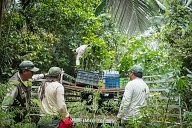
Dirty gold from Peru
Olivier Donnars / Le Pictorium
LePictorium_0234887.jpg
The shipment of plants leaves for the devastated part of the Tambopata National Reserve, under the watchful eye of the marines and rangers of the National Service of State Protected Natural Spaces (Sernanp). On a chaotic track, about 30,000 plants must be transported from the military entry post to the reforestation point in the Tambopata National Park . The 20 kilometers or so require 3 to 4 hours of motorcycle riding on a dirt track with rough wooden bridges. However, travel conditions have clearly improved. At the time of the occupation of La Pampa by the miners, it sometimes took a whole day to enter the heart of the area.
Next page
